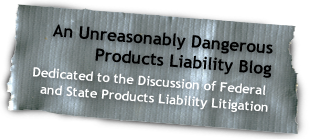
During a recent bout of insomnia, I found myself reading Sun Tzu’s The Art of War. I have read the ancient Chinese military treatise several times over the years but never during my time as a practicing attorney. As I read the text, now through the eyes of a litigator, I realized that all attorneys could learn from Sun Tzu’s wisdom. Aside from his guidance on the proper usage of spies, attacks by fire, and whatnot, Sun Tzu’s military stratagem is a perfect litigation guide book. While a quick Google search reveals that I was not the first to make this observation, we here at Abnormal Use now offer our perspective on the issue (in a multi-part series, of course).
As an initial matter, we must caution that we by no means view litigation as “war” in the traditional sense. In our experience, litigation is most often handled with the utmost civility between attorneys fairly representing their clients. While litigation is adversarial, we do not suggest it should be hostile. Rather, we contend that some of Sun Tzu’s strategies can aid litigators in effective advocacy.
With this backdrop, we begin our series by analyzing the following tactic from “Laying Plans,” the first chapter of the book:
[W]hen able to attack, we must seem unable; when using our forces, we must seem inactive; when we are near, we must make the enemy believe we are far away; when far away, we must make him believe we are near.
Much of “Laying Plans” deals with deception in warfare. While we condemn unethical deceptions in litigation, Sun Tzu’s general premise is well-taken. When you are weak, you must appear strong. When you are strong, you must appear weak. When we enter a courtroom and stand before a judge or a jury, we must speak with confidence. Regardless of the challenges we might face in arguing our positions, we must speak authoritatively. If we do not act and speak like we should prevail, then we should not expect to do so.
A former professor tells a story from his early days of practice. He was to try a criminal case in front of an unfamiliar judge. He received a tip from a local practitioner that the judge was a real stickler for the rules of evidence and, when the judge would hear something objectionable, he would look up from his notes and tilt his head slightly to the right. With this tip in mind, the professor made a point to observe the judge for the duration of the trial. Every time the judge tilted his head, the professor stood and objected. Without pause, the judge sustained every objection. Even though the professor’s client was ultimately convicted, the judge spread the word of a young attorney who knew the rules of evidence better than any other lawyer who had appeared before him. As a result, the professor quickly became known among the bar as an evidence expert. Little did they know that he had earned a “C” in his evidence class at Duke Law School. They also never suspected that if the judge had asked him to specify the grounds for his objections, he would have fainted on the spot. Nonetheless, he owed his newfound stardom to his ability to speak with authority.
Conversely, there is also merit, as Sun Tzu suggests, to appearing “weak” when you are strong. By “weak,” we do not necessarily mean acting as if you do not know the law. Rather, the appearance of “weakness” can be much more subtle and nuanced. For example, when we have what we believe to be a strong case, it is natural to state that position up front to opposing counsel. While there is a time and place for that, there is much to be said by holding back. As good as your case may be, it is likely not as good as you suspect. There are no “perfect” cases. As such, rather than championing your position and showing all your cards, be more reserved. Let opposing counsel share his or her side first. It will help you to better assess the holes in you case (which are undoubtedly there).
When in law school, I participated in a civil practice program which allowed 3L students to gain experience by representing indigent parties under the supervision of a licensed attorney. In handling a landlord-tenant matter, I called opposing counsel, an experienced attorney 30 years my senior. After a pleasant conversation, I hung up the phone and saw a scowl from my supervisor. She informed me that I had put myself in a bad position – not because of the substance of the conversation – but because I had said, “Yes, sir” (as any good Southerner would do). As such, she believed that I had placed myself in an inferior position and would remain that way throughout the litigation. The case ultimately resolved favorably for my client. While I agree that we should show strength when we are weak, I did not agree with my supervisor at the time, nor do I agree with her now. Call it “weakness” or “strength,” but not enough can be said about simply being friendly to opposing counsel. Regardless of how good (or bad) my case may be, a little bit of kindness goes a long way in litigation. Resolving disputes is never easy, but it is much easier when you have friends on the other side.
Sun Tzu would have said the same, right?
Note: An online translation of The Art of War can be accessed here.

















